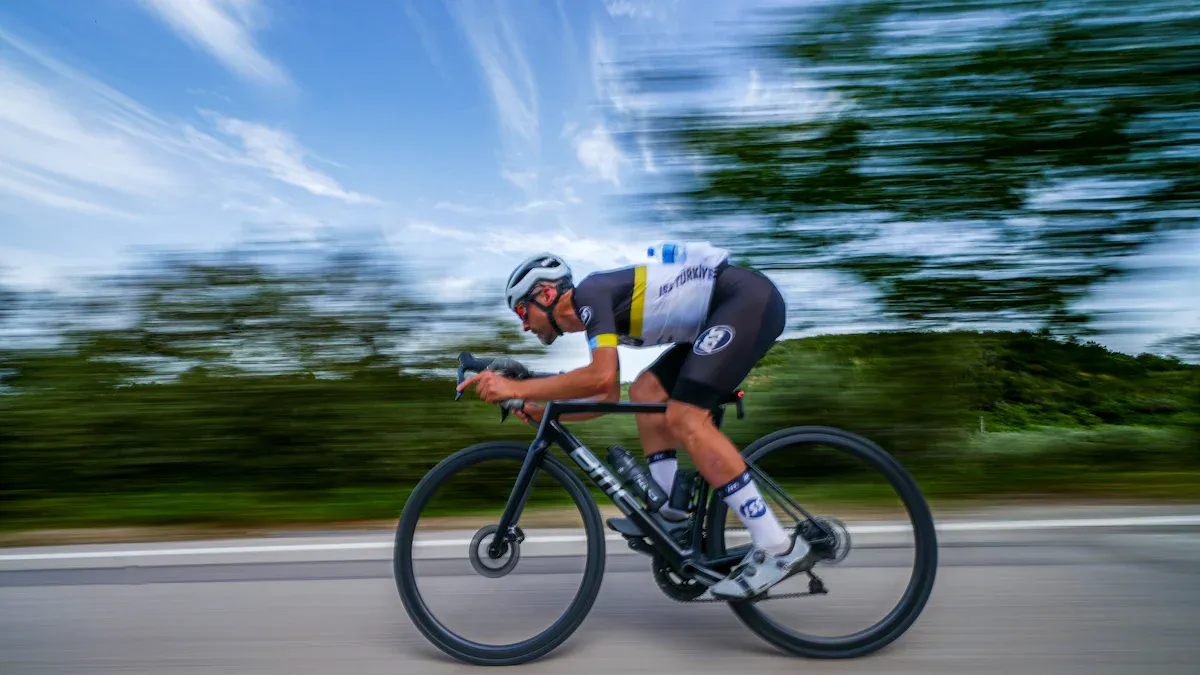
If you look at a time trial bike frame and a triathlon bike, you’ll spot big differences right away. UCI rules shape every detail of a time trial bike, forcing strict limits on bar angles and frame design. A triathlon bike skips these rules, giving you more comfort, storage, and creative frame shapes. Both tt and triathlon bikes use steep seat tube angles for speed, but a triathlon bike lets you ride longer and save energy for the run. These changes really affect your performance and how each bike feels in a race.
Key Takeaways
Time trial bikes must follow UCI rules. These rules limit how the frame looks and how you sit. The bikes are made for speed in short races.
Triathlon bikes are built for comfort. You can adjust the fit to suit you. They have storage for your gear. This helps you ride longer and run better after biking.
Triathlon bikes have steeper seat tube angles. This moves you forward on the bike. It helps save your hamstrings and makes you less tired.
The frame shapes and riding positions are not the same. Time trial bikes use a more aggressive aero setup. Triathlon bikes try to balance speed and comfort.
Disc brakes help you stay safe and in control. They work well in all weather. Most triathlon bikes use disc brakes. Rim brakes are lighter but not as good in wet weather.
Time Trial Bike Frame vs Triathlon Bike Frame

UCI Rules and Design Limits
When you look at a time trial bike frame, you’ll notice it follows strict rules set by the UCI. These rules control almost every part of the bike frame design. The UCI sets limits on how far your handlebars can reach, how high your arm pads can go, and even the angle of your forearm supports. These limits change based on your height. Here’s a quick look at the main rules:
Rider Height Category | Max Horizontal Distance from Bottom Bracket to Extension End | Max Height Difference Between Forearm Support and Extension End | Max Inclination Angle of Forearm Support |
|---|---|---|---|
Less than 180 cm | 80 cm | Less than 10 cm | Increased from 15° to 30° |
180 – 189.9 cm | 83 cm | Less than 12 cm | Increased from 15° to 30° |
190 cm or more | 85 cm | Less than 14 cm | Increased from 15° to 30° |
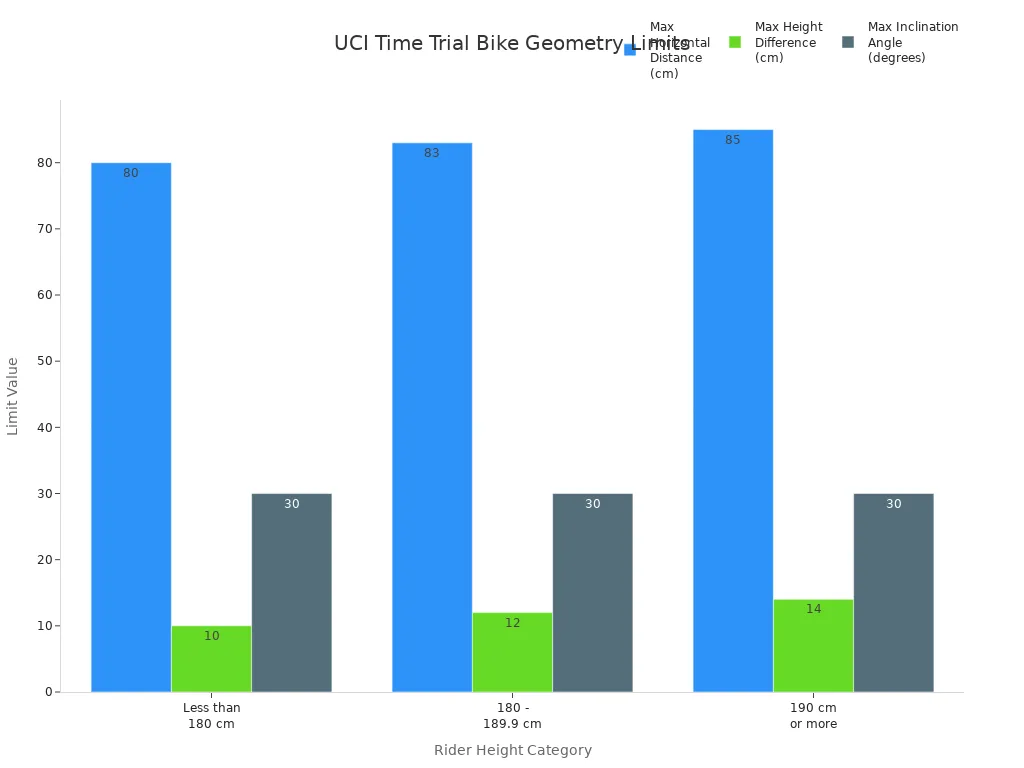
The UCI also controls the shape and weight of your time trial bike frame. For example:
The frame tubes must fit inside an 8cm “box.” This stops designers from making wild, super-aero shapes.
There’s a minimum weight for the bike, and the UCI wants to make it even heavier to keep bikes strong and safe.
The UCI wants all the parts to fit together in standard ways, so you can swap parts more easily.
Teams can only use a certain number of frames and parts each season, so brands build bikes that last longer.
These rules make every tt bike look and feel similar. You get less freedom to change your position or add special features. If you race in UCI events, you must follow these limits.
A triathlon bike gives you much more freedom. You don’t have to worry about UCI rules. Designers can use creative frame geometry, wild tube shapes, and even add storage boxes or hydration systems right into the frame. You can set up your cockpit just how you like it, with longer extensions or higher arm pads for comfort. This freedom lets you focus on comfort and performance for long races.
Tip: If you want the most adjustable and comfortable ride, a triathlon bike is the way to go. If you plan to race in UCI events, you need a time trial bike frame that meets all the rules.
Geometry Differences
The biggest difference between a tt bike and a triathlon bike comes from the frame geometry. This means the angles and lengths of the tubes that make up the bike. The seat tube angle and saddle position matter most.
Bike Type | Typical Seat Tube Angle (degrees) | Saddle Position Relative to Bottom Bracket |
|---|---|---|
Time Trial (TT) | Approximately 74 – 76 | Saddle generally behind or near BB |
Triathlon Bikes | Approximately 77 – 81 | Saddle typically 2 cm or more forward of BB |
A time trial bike frame usually has a seat tube angle between 74° and 76°. The saddle sits behind or right above the bottom bracket. This puts your hips behind your feet, which works well for short, hard efforts. You can push big power, but it can feel tough on your hamstrings and lower back during longer rides.
A triathlon bike uses a steeper seat tube angle, usually between 77° and 81°. The saddle moves forward, often 2 cm or more ahead of the bottom bracket. This change pushes your hips forward, almost like you’re getting ready to run. You use your quads more and save your hamstrings. This setup helps you ride longer and feel fresher when you start running.
Biomechanical studies show that when you ride a triathlon bike with a steeper seat tube angle, you keep your power high but use your hamstrings less. This means less muscle fatigue and a better run after the bike. You also get a more comfortable ride, especially in long races. The forward position helps you stay low and aero without hurting your back or neck.
A tt bike frame geometry works best for short, fast races where you want max speed and don’t need to run after.
A triathlon bike frame geometry helps you ride longer, stay comfortable, and run better off the bike.
Note: If you plan to do long triathlons or want to feel good during the run, pick a triathlon bike with a steeper seat tube angle and a forward saddle.
Riding Position and Fit
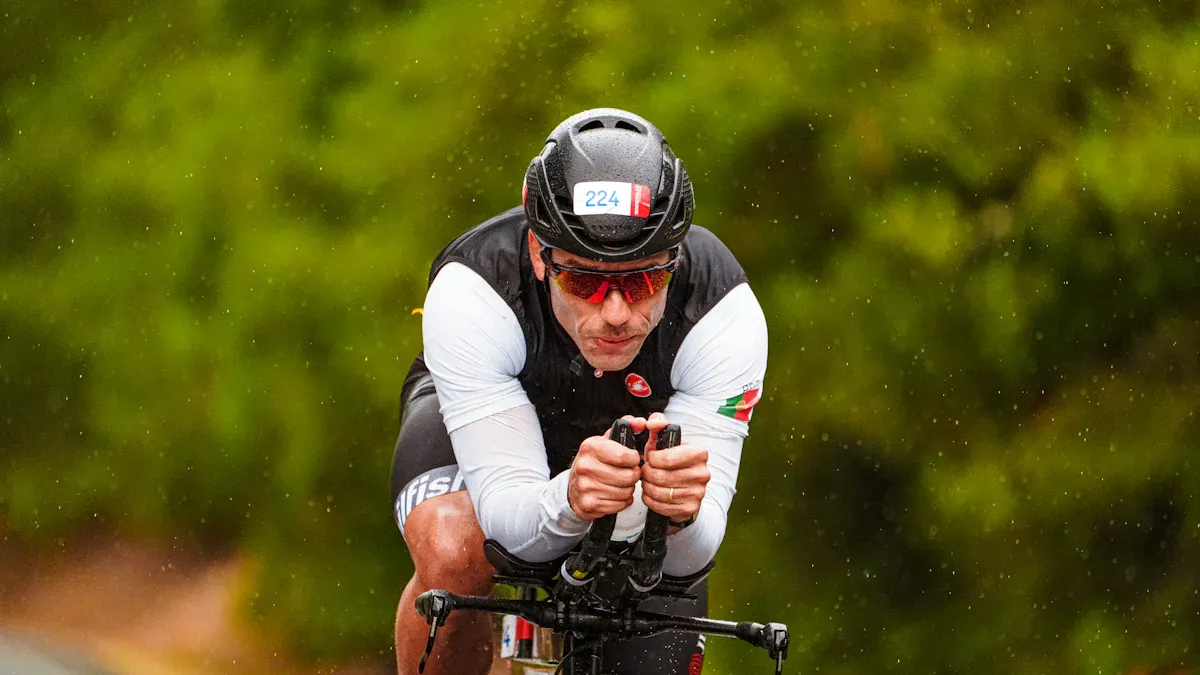
Time Trial Bike Fit
When you ride a time trial bike, you chase pure speed. The time trial position puts you low and stretched out, so you cut through the wind. Most tt bikes use a cockpit that keeps your elbows close and your hands high. This setup helps you stay in a tight aero position, which means less drag and more speed. Take a look at the table below to see how different cockpit setups affect your aerodynamics:
Cockpit Setup | Description | Aerodynamic Effect / Drag Reduction | Notes on Practicality and Regulations |
|---|---|---|---|
Baseline | Standard hand and elbow position | Reference point | – |
Wide Elbows | Elbows slightly wider within torso silhouette | Small increase in frontal area but improved flow | |
Narrow Elbows | Elbows brought closer together | 4.3% reduction in drag area (CdA) | Further aerodynamic improvement |
High Hands Narrow Elbows | Hands raised with narrow elbows | 7.7% reduction in drag area (CdA) | Balances aerodynamic gain and forward vision |
Very High Hands Narrow Elbows | Hands raised ~35° angle, narrow elbows | 11.2% reduction in drag area (CdA) | Most aerodynamic but likely violates UCI rules |
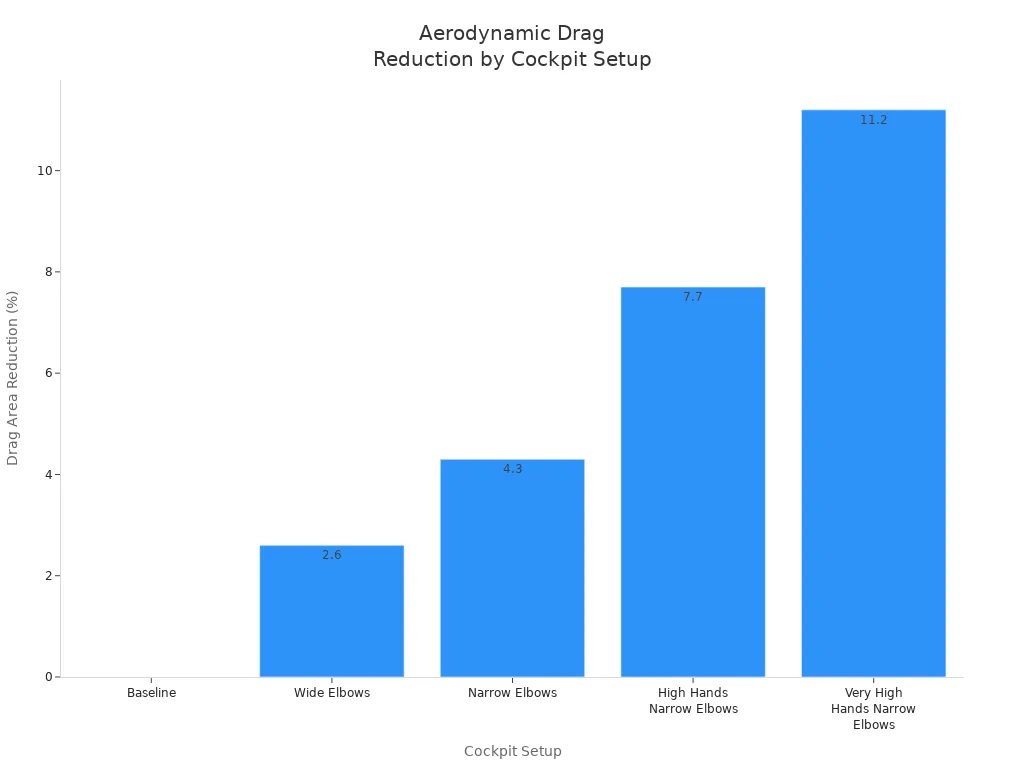
You can see that raising your hands and narrowing your elbows makes you faster. But if you go too extreme, you might break UCI rules or lose comfort. Most tt bikes let you adjust your cockpit a little, but you still need to follow the rules. The main goal is to hold your time trial position for a short, hard effort—like a 40 km race—where every second counts.
Triathlon Bike Comfort
A triathlon bike gives you more ways to adjust your fit. You can move your handlebars, aero bars, and arm pads to match your body and race. This helps you ride longer and feel better, even after hours on the bike. Here’s how a triathlon bike cockpit helps you:
You can fine-tune the reach, stack, and tilt of your pads and extensions.
Small changes relieve pressure on your neck, shoulders, and hands.
You can adjust your setup for each race, from a sprint to a full Ironman.
A good bike fit helps you breathe easier and digest food better during long rides.
You can make changes without needing a new bike—just a fitting session.
When you ride a triathlon bike, you sit in a position that saves your legs for the run. The steeper seat tube angle and forward saddle help you use your quads more and your hamstrings less. Studies show that this setup lowers your fatigue and helps you run faster after the bike. By changing your hand and torso position, you keep your center of mass steady, which makes your run smoother and easier.
Tip: If you want to feel strong on the run, focus on your triathlon bike fit. A small change in your position can make a big difference in your race.
Aerodynamics
Frame Shapes
When you look at time trial and triathlon bikes, you’ll notice some wild frame shapes. Designers use these shapes to help you slice through the wind. Time trial bikes often feature sharp trailing edges, like the Cervelo P5. This design works great when you ride straight into the wind, but it can feel twitchy if the wind hits you from the side. Triathlon bikes, such as the Trek SC, use a Kamm tail shape. This shape keeps the airflow attached to the frame, even when the wind comes from different angles. You get better handling and less drag in crosswinds.
Bike makers test these shapes using wind tunnels and computer simulations. They look at drag coefficient and frontal area to measure how slippery the bike is. You’ll see features like dropped downtubes, oversized tubes with Kamm tails, and hidden brakes. Some bikes even remove seatstays to shrink the frontal area. Triathlon bikes go further with integrated storage for hydration and tools, keeping everything smooth and fast. You get more creative designs because triathlon bikes don’t have to follow UCI rules.
Here are some common aerodynamic frame features you’ll find:
Dropped downtubes for better airflow near the front wheel
Oversized tubes with truncated tails to balance stiffness and aerodynamics
Integrated brakes and cables to reduce drag
Storage systems built into the frame for nutrition and hydration
Tip: If you want a bike that handles well in all wind conditions, look for a frame with a Kamm tail design.
Speed and Efficiency
Aerodynamics play a huge role in your speed. The frame shape helps, but your position on the bike matters even more. Time trial bikes push you into a tight, aggressive aero position. You tuck your elbows and stretch out, cutting drag as much as possible. This setup gives you top performance for short races, but it can feel tough to hold for a long time.
Triathlon bikes let you sit a bit more relaxed. You still get an aerodynamic position, but you can stay comfortable for hours. The steeper seat tube angle moves your hips forward, saving your legs for the run. You get a balance between speed and comfort, which means you can ride fast and still feel strong when you hit the run course.
Both bike types use short wheelbases and low stack heights to keep you low and fast. Triathlon bikes add features for storage and hydration, so you don’t have to slow down for fuel. Wheels with deep profiles also help you go faster, but they can make the bike harder to handle in strong winds.
Note: Your riding position and equipment, like your helmet and suit, often affect aerodynamics more than the frame itself. A good fit helps you hold your aero position and get the most out of your bike.
Storage and Hydration
Triathlon Bike Storage
When you ride a triathlon bike, you get lots of smart storage options. Designers build storage right into the frame, so you can carry water, gels, and tools without slowing down. You might see a hidden compartment in the downtube or a top tube box for snacks. These features help you grab what you need quickly and stay in your aero position.
Take a look at this table to see how different bikes compare:
Bike Model | Integrated Hydration Volume | Hydration Design & Accessibility Features | Comparison to Time Trial Bikes |
|---|---|---|---|
Cube Aerium C:68X | 1500 mL | In-frame hydration bladder, between-the-arms system; big capacity, setup takes effort. | More storage and easier access than TT bikes. |
Cadex Tri | 600-1000 mL | Internal hydration, up to 10 gels, built-in toolkit; modular front end. | More specialized than TT bikes. |
BMC Speedmachine 01 LTD | 1200 mL | Large frame-shaped bottle with hose; aftermarket mounts for nutrition. | Bigger hydration than TT bikes. |
Canyon Speedmax CF SLX 7 | 500-700 mL | In-frame hydration; top tube nutrition storage. | Less hydration than some triathlon bikes. |
Quintana Roo V-PRi | 650-750 mL | Fully integrated hydration and nutrition; easy to fill and clean. | More accessible than TT bikes. |
Cervelo P5 (TT bike) | 500 mL | Frame-mounted bottle, rear-mount bracket; limited volume, hard to refill. | Smaller capacity, less storage. |
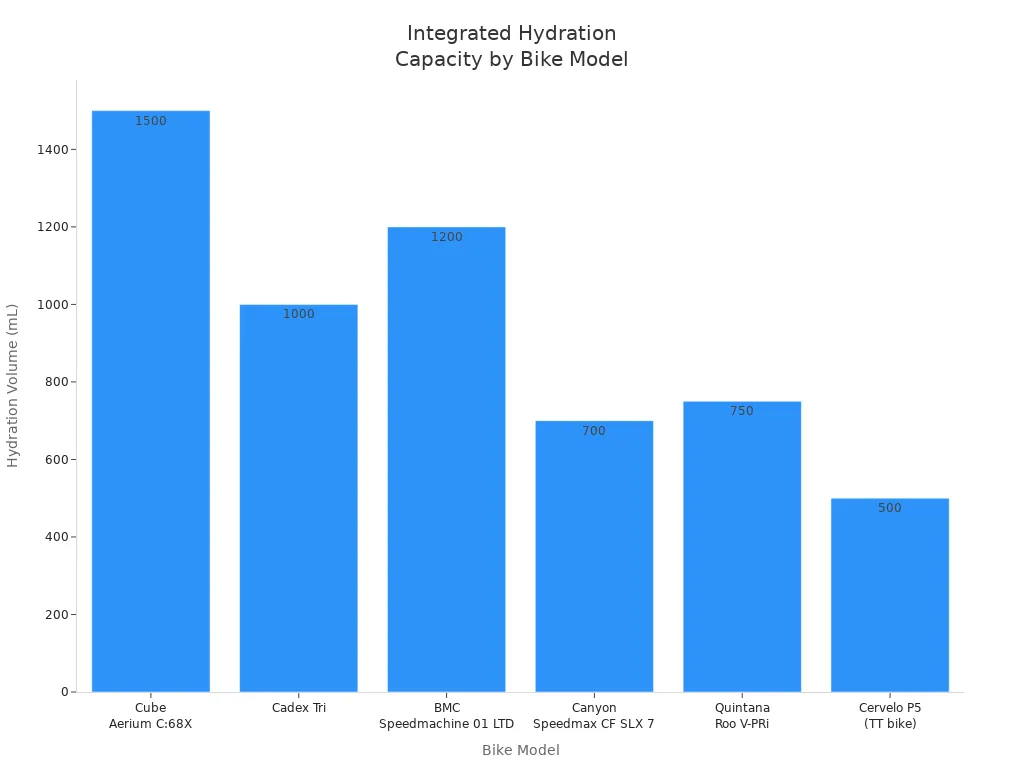
You’ll find top tube bags for gels and bars, rear-mounted systems for tools, and even insulated compartments. These storage solutions blend into the bike’s shape, so you stay fast. Some bikes, like the Factor SLiCK, use hollow frame space for tools and food, keeping everything hidden and easy to reach. You don’t have to break your aero position to grab a drink or snack.
Tip: Good storage saves time and keeps you focused on your race. You can fuel up without slowing down or losing speed.
Time Trial Bike Storage
Time trial bikes keep things simple. UCI rules limit what you can add, so you usually get just one or two water bottles. Most storage sits outside the frame, which can make it harder to reach and refill. You might use a frame-mounted bottle or a rear bracket, but the volume stays small—about 500 mL.
Here’s what you’ll notice:
Less onboard storage than a triathlon bike.
Hydration systems are basic, often just a bottle on the frame.
You need to stop or slow down to refill or grab nutrition.
Storage options focus on keeping the bike light and aerodynamic.
Triathlon bikes win when it comes to storage and hydration. You get bigger capacity, easier access, and more choices for long races. Time trial bikes stick to the basics, following strict rules to stay fast and light.
Brake Technology
Disc Brakes
You’ve probably noticed that more triathlon bikes now come with disc brakes. This change isn’t just about looking modern. Disc brakes give you stronger and more reliable stopping power. You can trust them in all kinds of weather—rain, heat, or even on steep descents. That’s a big deal when you’re racing on courses with sharp turns or sudden hills.
Here’s why disc brakes are becoming the top choice:
You get better control when climbing, descending, or cornering.
Disc brakes work great in wet conditions, so you don’t have to worry about slippery roads.
You need less hand strength to stop, which helps on long rides.
The thru-axle design keeps your wheels secure and stiff.
Hidden brake cables make your bike look cleaner and more aerodynamic.
Most new triathlon bikes use disc brakes because they help you ride safer and faster. Even though disc brakes add a little weight and need fluid changes for maintenance, the benefits outweigh these small drawbacks. You also don’t have to worry about wearing out your wheel rims, which means your wheels last longer.
Tip: Don’t worry about losing speed. Modern disc brakes don’t slow you down. Tests show they don’t add extra drag, so you stay fast and safe.
Rim Brakes
Rim brakes used to be the standard on both time trial and triathlon bikes. They’re lighter and simpler, which is why some time trial bikes still use them. Rim brakes work well on flat, dry courses where you don’t need to stop often.
Check out this quick comparison:
Aspect | Rim Brakes on TT Bikes | Rim Brakes on Triathlon Bikes (vs. Disc Brakes) |
|---|---|---|
Weight | Lighter, simple design | Still lighter than disc brakes |
Braking Efficiency | Good on flat, dry roads | Not as strong, especially in wet conditions |
Wet Conditions | Less reliable, risky on carbon rims | Can be dangerous when wet |
Maintenance & Cost | Cheap, easy to fix | Cheaper, but can wear out your rims |
Aerodynamics | Slightly more aero | Disc brakes now match or beat rim brakes for aero |
Wheel Options | Limited by caliper size | Disc brakes allow wider, faster tires |
Rim brakes are easy to maintain and cost less, but they don’t work as well in the rain. Many riders now see rim brakes as old tech, especially since disc brakes keep getting better. If you want the lightest setup for a flat time trial, rim brakes might still work for you. For most triathletes, disc brakes are the safer, smarter choice.
Event Suitability
Best for Time Trials
If you want to go as fast as possible in a solo race against the clock, a tt bike is your best friend. These bikes are built for pure speed on flat or rolling courses. The frame, cockpit, and wheels all work together to help you cut through the wind. You ride in a low, stretched-out position that feels aggressive but lets you push big power for short distances. UCI rules shape every part of a tt bike, so you get a race bike that’s all about aerodynamics and efficiency. You’ll notice that tt bikes shine in time trial events where every second counts and comfort takes a back seat.
Tip: If your main goal is to win time trials or compete in UCI events, stick with a tt bike for the best results.
Best for Triathlons
A triathlon bike is made for the unique demands of triathlon races. You need to save your legs for the run, so the bike puts you in a more forward position. This setup helps you use your muscles better and keeps you comfortable over long distances. You also get built-in storage for water, snacks, and tools, which means you can fuel up without slowing down. Triathlon bikes let you adjust your fit more, so you can find the perfect position for your body and race goals. For long events like Ironman, comfort and storage matter just as much as speed.
Feature | Triathlon Bike | TT Bike |
|---|---|---|
Comfort | High (adjustable fit) | Lower (fixed position) |
Storage | Integrated | Minimal |
Run Readiness | Excellent | Not designed for run |
Versatility
You might wonder if you can use one bike for everything. In mixed-discipline or non-standard events, the answer isn’t simple. Studies from virtual races like the Virtual Tour de France show that tt and triathlon bikes do best in their own fields. When you face courses with lots of changes, hills, or group tactics, the benefits of a tt bike or triathlon bike become less clear. Success depends on more than just aerodynamics. You need to think about power, comfort, and even how you handle the bike. If you want a bike that can handle different events, look for one with adjustable fit and some storage. But remember, no single bike is perfect for every race.
Note: Always match your bike choice to your event. Think about distance, course type, and what matters most—speed, comfort, or flexibility.
Picking a time trial bike frame or a triathlon bike depends on what you want and the kind of race. Here’s a simple table to help you compare:
Aspect | Time Trial Bike Frame | Triathlon Bike |
|---|---|---|
Comfort | More aggressive, not easy to adjust | More relaxed, easier to adjust |
Storage | Not much storage, can change how fast you go | Built-in storage, easy to reach |
Best Use | Good for flat, solo races with no drafting | Great for long races with a run after |
If you want to go as fast as possible in short, flat races, pick a time trial bike frame. If you care about comfort, need storage, or want to run well after biking, choose a triathlon bike. Always pick your bike based on the course, how comfy you want to be, and how much storage you need.
FAQ
What’s the main difference between a time trial bike and a triathlon bike?
You’ll notice time trial bikes follow strict UCI rules. Triathlon bikes offer more comfort and storage. Time trial bikes focus on pure speed. Triathlon bikes help you ride longer and run better after biking.
Can you use a time trial bike in a triathlon race?
You can use a time trial bike in most triathlons. You might miss out on comfort and storage. Triathlon bikes make fueling and long rides easier. You’ll feel fresher for the run.
Do triathlon bikes really help you run faster?
Yes! Triathlon bikes use a steeper seat tube angle. You save your hamstrings and use your quads more. You’ll finish the bike leg with less fatigue and run stronger.
Are disc brakes better for triathlon or time trial bikes?
Disc brakes give you better stopping power and control. You’ll feel safer in wet weather or on hilly courses. Most new triathlon bikes use disc brakes. Some time trial bikes still use rim brakes for lighter weight.
See Also
Key Differences Between Triathlon And Time Trial Bike Frames
Distinct Features That Separate Track Bike Frames From Others
Comparing Fat Bike Frames Versus Mountain Bike Frames Explained
Guide To Evaluating Carbon Race Bike Frames For Performance
Understanding Racing Bike Frame Size Charts For All Cyclists
